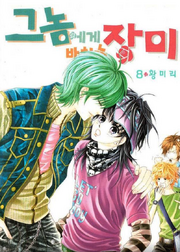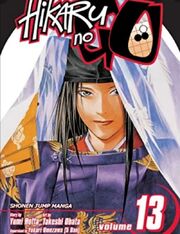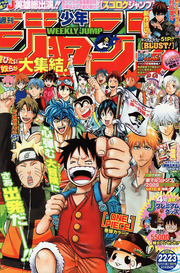



Manga (kanji: 漫画; hiragana: まんが; katakana: マンガ; pronunciation: ˈmɑːŋɡə) consist of comics and print cartoons (sometimes also called komikku, コミック) in the Japanese language and conforming to the style developed in Japan in the late 20th century.
In Japan, people of all ages read manga. The genre includes a broad range of subjects: action-adventure, romance, sports and games, historical drama, comedy, science fiction and fantasy, mystery, horror, sexuality, and business and commerce, among others. Since the 1950s, manga have steadily become a major part of the Japanese publishing industry, representing a 406 billion yen market in Japan in 2007 (approximately $3.6 billion). Manga have also become increasingly popular worldwide. In 2008, the U.S. and Canadian manga market was $175 million. Manga are typically printed in black-and-white, although some full-color manga exist (e.g. Colorful). In Japan, manga are usually serialized in telephone book-size manga magazines, often containing many stories, each presented in a single episode to be continued in the next issue. If the series is successful, collected chapters may be republished in paperback books called tankōbon. A manga artist (mangaka in Japanese) typically works with a few assistants in a small studio and is associated with a creative editor from a commercial publishing company. If a manga series is popular enough, it may be animated after or even during its run, although sometimes manga are drawn centering on previously existing live-action or animated films. Some manga are produced based on light novels where the manga has much more illustration and sometimes differing or independent story lines.
Sometimes manga use an original anime or live-action series as source material and adapt it to the manga format and presentation. Another recent phenomenon is manga being the source material for live-action stage plays or musicals. Also possibly due to saturation of the anime production capacity, many manga have now been adapted as live-action series or films first and then anime later (i.e. The Way of the Househusband was adapted as a live-action series first and then later adapted as a series of ONA shorts; also Police in a Pod was adapted as a live-action series first and then later adapted as an anime series).
Similar forms in other countries[]
"Manga" as a term used outside Japan refers specifically to comics originally published in Japan. However, manga-influenced comics, among original works, exist in other parts of the world, particularly in South Korea ("manhwa") or Taiwan (Republic of China) and the People's Republic of China, notably Hong Kong ("manhua"). In France, "la nouvelle manga" has developed as a form of bande dessinée (literally drawn strip) drawn in styles influenced by Japanese manga. In the United States, people refer to manga-like comics or graphic novels as Amerimanga, world manga, or original English-language manga (OEL manga).
Publications[]
In Japan, manga constituted an annual 406 billion yen (approximately $3.6 billion USD) publication-industry by 2007[1] and grew to over 670 billion yen (almost $5 billion USD) by 2022.[2] Recently, the manga industry has expanded worldwide, where distribution companies license and reprint manga into their native languages.
After a series has run for a while, publishers often collect the stories together and print them in dedicated book-sized volumes, called tankōbon. These are the equivalent of U.S. trade paperbacks or graphic novels. These volumes use higher-quality paper, and are useful to those who want to "catch up" with a series so they can follow it in the magazines or if they find the cost of the weeklies or monthlies to be prohibitive. Recently, "deluxe" versions have also been printed as readers have gotten older and the need for something special grew. Old manga have also been reprinted using somewhat lesser quality paper and sold for 100 yen (about $1 U.S. dollar) each to compete with the used book market.
Marketeers primarily classify manga by the age and gender of the target readership. In particular, books and magazines sold to boys (shōnen) and girls (shōjo) have distinctive cover art and are placed on different shelves in most bookstores. Due to cross-readership, consumer response is not limited by demographics. For example, male readers subscribing to a series intended for girls and so on.
There has been an increase in the amount of publications of original web manga. It is internationally drawn by enthusiasts of all levels of experience, and is intended for online viewing. It can be ordered in graphic novel form if available in print.
The Kyoto International Manga Museum maintains a very large website listing manga published in Japanese.
Magazines[]

Manga magazines usually have many series running concurrently with approximately 20–40 pages allocated to each series per issue. Other magazines such as the anime fandom magazine Newtype featured single chapters within their monthly periodicals. Other magazines like Nakayoshi feature many stories written by many different artists; these magazines, or "anthology magazines", as they are also known (colloquially "phone books"), are usually printed on low-quality newsprint and can be anywhere from 200 to more than 850 pages thick. Manga magazines also contain one-shot comics and various four-panel yonkoma (equivalent to comic strips). Manga series can run for many years if they are successful. Manga artists sometimes start out with a few "one-shot" manga projects just to try to get their name out. If these are successful and receive good reviews, they are continued. Magazines often have a short life.
Some of the most popular manga magazines are Weekly Shōnen Jump, Weekly Shōnen Magazine, CoroCoro Comic, Big Comic Original, Weekly Young Jump, Weekly Young Magazine, Monthly Shōnen Magazine, Big Comic, Weekly Shōnen Sunday, Weekly Shōnen Sunday, Ciao, Comic Ran, Jump Square, Ribon, Bessatsu Friend, and Nakayoshi.
Dōjinshi[]
Main article: Dōjinshi Dōjinshi, produced by small publishers outside of the mainstream commercial market, resemble in their publishing small-press independently published comic books in the United States. Comiket, the largest comic book convention in the world with around 500,000 visitors gathering over three days, is devoted to dōjinshi. While they most often contain original stories, many are parodies of or include characters from popular manga and anime series. Some dōjinshi continue with a series' story or write an entirely new one using its characters, much like fan fiction. In 2007, dōjinshi sold for 27.73 billion yen (245 million USD).
Digital manga[]
Thanks to the advent of the internet, there have been new ways for aspiring mangaka to upload and sell their manga online. Before, there were two main ways in which a mangaka's work could be published: taking their manga drawn on paper to a publisher themselves, or submitting their work to competitions run by magazines. Of course, this also includes digital versions and digital originals from trditional manga publishers.
Web manga[]
In recent years, there has been a rise in manga released digitally. Webmanga (or "webcomic"), as it is known in Japan (although it is not really different from the more general Western web comic), has seen an increase thanks in part to image hosting websites where anyone can upload pages from their works for free. Although released digitally, almost all web manga sticks to the conventional black-and-white format (also read right to left) despite some never getting physical publication. Pixiv is the most popular site where amateur and professional work gets published on the site. It has grown to be the most visited site for artwork in Japan. Twitter has also become a popular place for web manga with many artists releasing pages weekly on their accounts in the hope of their work getting picked up or published professionally. One of the best examples of an amateur work becoming professional is One-Punch Man which was released online and later received a professional remake released digitally and an anime adaptation soon thereafter.
Many of the big print publishers have also released digital only magazines and websites where web manga get published alongside their serialized magazines. Shogakukan for instance has two websites, Sunday Webry and Ura Sunday, that release weekly chapters for web manga and even offer contests for mangaka to submit their work. Both Sunday Webry and Ura Sunday have become one of the top web manga sites in Japan. Some have even released apps that teach how to draw professional manga and learn how to create them. Weekly Shōnen Jump released Jump Paint, an app that guides users on how to make their own manga from making storyboards to digitally inking lines. It also offers more than 120 types of pen tips and more than 1,000 screentones for artists to practice. Shueisha released Shonen Jump+ in 2014 that includes original releases with some digital releases of Weekly Shōnen Jump titles and later in 2019 launched Manga Plus for releases outside Japan. Kodansha has also used the popularity of web manga to launch more series and also offer better distribution of their officially translated works under Kodansha Comics thanks in part to the titles being released digitally first before being published physically.
The rise web manga has also been credited to smartphones and computers as more and more readers read manga on their phones rather than from a print publication. While paper manga has seen a decrease over time, digital manga have been growing in sales each year. The Research Institute for Publications reports that sales of digital manga books excluding magazines jumped 27.1 percent to ¥146 billion in 2016 from the year before while sales of paper manga saw a record year-on-year decline of 7.4 percent to ¥194.7 billion. They have also said that if the digital and paper keep the same growth and drop rates, web manga would soon exceed their paper counterparts. In 2020, manga sales topped the ¥600 billion mark for the first time in history, beating the 1995 peak due to a fast growth of the digital manga market which rose by ¥82.7 billion from a previous year, surpassing print manga sales which have also increased.
Webtoons[]
Main article: Webtoon While webtoons have caught on in popularity as a new medium for comics in Asia (primarily in South Korea), Japan has been slow to adopt webtoons as the traditional format and print publication still dominate the way manga is created and consumed (although this is beginning to change). Despite this, one of the biggest webtoon publishers in the world, Comico, has had success in the traditional Japanese manga market. Comico was launched by NHN Japan, the Japanese subsidiary of Korean company, NHN Entertainment. As of now,&&91;when?] there are only two webtoon publishers that publish Japanese webtoons: Comico and Naver Webtoon (under the name XOY in Japan). Kakao has also had success by offering licensed manga and translated Korean webtoons with their service Piccoma. All three companies credit their success to the webtoon pay model where users can purchase each chapter individually instead of having to buy the whole book while also offering some chapters for free for a period of time allowing anyone to read a whole series for free if they wait long enough.[92] The added benefit of having all of their titles in color and some with special animations and effects have also helped them succeed. Some popular Japanese webtoons have also gotten anime adaptations and print releases, the most notable being ReLIFE and Recovery of an MMO Junkie.
Awards[]
The Japanese manga industry grants a large number of awards, mostly sponsored by publishers, with the winning prize usually including publication of the winning stories in magazines released by the sponsoring publisher. Examples of these awards include:
- Akatsuka Award for humorous manga
- Dengeki Comic Grand Prix for one-shot manga
- Kodansha Manga Award (multiple genre awards)
- Seiun Award for best science fiction comic of the year
- Shogakukan Manga Award (multiple genres)
- Tezuka Award for best new serial manga
- Tezuka Osamu Cultural Prize (multiple genres)
The Japanese Ministry of Foreign Affairs has awarded the International Manga Award annually since May 2007.
Media[]
Videos[]
References[]
- ↑ Inside Games - 2007年のオタク市場規模は1866億円―メディアクリエイトが白書 2007.12.18 Tue 15:27
- ↑ Anime News Network - Manga Market Reaches Record 677 Billion Yen in Japan in 2022 by Rafael Antonio Pineda, Crystalyn Hodgkins 2023-02-28 06:28 EST
See also[]
External links[]
- Related
- Anime and Manga Studies - a site that highlights announcements and news relevant to the anime/manga studies community
- NHK - ANIME MANGA EXPLOSION TV show (every Sunday afternoon Japan time)
 Graphic novel
Graphic novel
- News
- Crazy for Anime Trivia - Artist Highlights Abuses in the Manga Industry by Shiki June 10, 2024
- PBS - What’s behind the growing popularity of Japanese comics and animations in U.S. By Ali Rogin, Claire Mufson, Michael Boulter May 18, 2024 5:30 PM EDT
- Anime News Network - ICv2: U.S. Manga Sales Increase By 9% in 2022 by Adriana Hazra 2023-03-03 15:30 EST
- Anime News Network - Manga Market Reaches Record 677 Billion Yen in Japan in 2022 by Rafael Antonio Pineda, Crystalyn Hodgkins 2023-02-28 06:28 EST
- Crunchyroll News - Japan's 2022 Manga Sales Reaches The Highest in History Again by Mikikazu Komatsu February 26, 2023 5:20pm PST
- Honey's Anime - The Shonen Jump Guide to Making Manga Review - Invaluable Career Advice From Real Mangaka by Brett Michael Orr 12:00 PM October 5, 2022
- Publishers Weekly - Manga Is Booming By Deb Aoki | Apr 29, 2022

